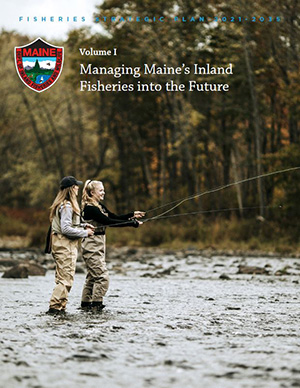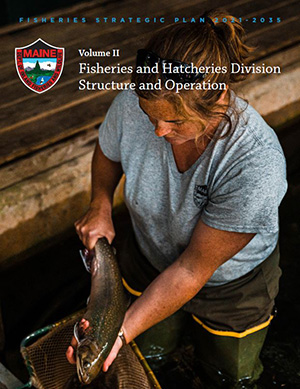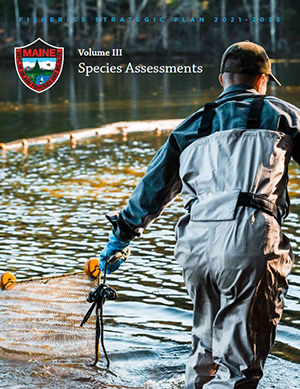Home → Fish & Wildlife → Fisheries → Maine's 2021–2035 Statewide Fisheries and Hatcheries Management Plan
Maine's 2021–2035 Statewide Fisheries and Hatcheries Management Plan
The 2021-2035 Fisheries Strategic Plan is the culmination of several years of planning, coordination, and public engagement. The plan’s goals and overall content were developed based on input received through a comprehensive angler survey, expertise and experience of Division staff, input from technical subcommittees, and a public review of the fully drafted plan. In addition, all work completed throughout this planning process was periodically reviewed and guided by a steering committee comprised of a diverse group of public stakeholders.
This plan will be effective for 15 years (2021–2035) and will be integrated into the Division’s work programs to support attainment of plan goals. These goals were developed based on the current status of fisheries and associated conservation and management needs and therefore may need to be revised and updated within the 15-year planning period in response to unanticipated changes or threats.
The plan is divided into three volumes:
Volume I: Managing Maine's Inland Fisheries into the Future
Learn about the strategic planning process and view goals for the Division and hatchery operations. You will also find goals and strategies for featured sport fish including Arctic charr, baitfish and rainbow smelt, black bass, brook trout, lake whitefish, landlocked Atlantic salmon, nonnative trout (rainbow, brown trout, and splake), and togue.
Volume II: Fisheries and Hatcheries Division Structure and Operation
Learn about the organization and operation of the Division, conservation and management of native fish, non-native species status and prevention strategies, data collection and analysis, the fishing regulation setting process, and more!
Volume III: Species Assessments
Learn about the life history, management, and current status and distribution of featured sport fish.
Statewide Fisheries Management Goals
Five core goals will guide the Division of Fisheries and Hatcheries’ general programmatic direction over the next 15 years.More specifics on hatchery operations and the conservation and management of key fish species are outlined in the Hatchery Goals and Featured Sport Fish Goals sections.
Goal 1: Maintain healthy fish populations and their habitat
Ensure freshwater fish populations remain healthy and are sustainably managed into the future.
Some actions to help reach this goal include:
- Conserve native fish species, particularly those exhibiting population decline, including state listed freshwater fish, as well as fish of greatest conservation need
- Use cost-effective modern scientific approaches to monitor, assess, and respond to changes in key sport fish, forage fish, and species of greatest conservation need
- Limit the spread and distribution of all aquatic invasive species, including fish pathogens, through surveillance, permitting, interagency coordination, research, remediation, and public outreach
- Implement actions identified in Maine’s state Wildlife Action Plan to conserve Species of Greatest Conservation Need
- Provide timely consultation recommendations to regulatory agencies (MDEP, LUPC, FERC, ACF, etc.) to limit potential impacts to fish and aquatic communities from proposed actions
- Provide technical support and collaborate with private landowners to develop research and implement appropriate solutions to address management and conservation challenges
- Coordinate and collaborate with state, federal, tribal, and non-governmental organization partners to manage state fishery interests
- Promote and direct conservation actions, including conservation of riparian habitat, habitat restoration, and habitat connectivity targeting the state’s highest priority wild native fisheries
- Manage for sustainable harvest of sport fish
- Manage harvest and recreational use of live fish as bait to support the popular practice of fishing with live fish as bait, where such practices do not threaten native coldwater fish populations
- Manage stocking and management programs considerate of potential negative interactions to native and wild fish through adherence to stocking guidelines, post stocking monitoring, research, interagency coordination, and consideration of hatchery fish sterilization techniques
Goal 2: Consider broad public interests in the development of stocking and management programs
Fisheries management is the science of blending biological needs of fish with public and social desires. Aside from actions that are entirely conservation-focused, a spectrum of management actions such as stocking and regulations can be implemented based on public interests and biological considerations. Effective management considers public opinions and preferences in the development of management objectives.
Some actions to help reach this goal include:
- Provide cost-effective diverse fishing opportunities throughout the state for both ice and open water anglers, focused on different social use opportunities such as fall fishing, remote fishing, urban fishing, family fishing, and fast action fishing (sunfish, chubs, etc.)
- Periodically survey anglers to assess public support for and direction of Division programs, and continue efforts by regional staff to engage with the public in various venues to increase awareness of public and Division management concerns
- Develop stakeholder-supported, water-specific fisheries management plans for the state’s most popular and important waters to increase transparency and public support for management direction and associated rulemaking and stocking actions
- Develop written management goals for waters not supported by formal plans to support management actions and review of public input regarding those actions
- Explore stocking initiatives and practices that not only enhance angling opportunities, but also are expected to provide meaningful public use benefits, considerate of investment costs
- Continue to explore additional opportunities for lawbook simplification and enhanced digital tools to make fishing laws easier for anglers to understand
Goal 3: Keep the public, stakeholders, and partners informed and encourage meaningful collaboration to build support for Division programs
As public values, attitudes, and communication technologies change, program relevancy, collaboration, and understanding become increasingly important. Because the way people communicate and access information has changed in recent decades, the strategies to reach currently engaged anglers and new audiences must also evolve.
Some actions to help reach this goal include:
- Increase angler recruitment, retention, and reactivation (“R3”) consistent with engagement and participation strategies developed in the Department’s R3 Plan
- Continue meaningful collaboration with other state agencies, federal agencies, and tribes to co-manage inland and migratory fisheries in a manner considerate of respective organization missions
- Recognize and acknowledge interests and available resources unique to special interest groups and collaborate where there is alignment with Division priorities, and shared interest in protection and enhancement of Maine’s freshwater fisheries
- Identify conservation priorities, create public awareness, and encourage potential partner investments to conserve wild native fishes, particularly considerate of the need to manage for resiliency in the face of a changing climate
- Continue collaboration with the Department’s Information and Education Division to develop and broadly disseminate information using current communication technologies, including information regarding freshwater fisheries management, angling opportunities, and the importance of native fish conservation
Goal 4: Encourage, and where possible provide, fair, equitable, safe, and permanent access to Maine’s public waters for fishing and boating
Population demographics and associated attitudes regarding public use are changing, and waterfront real estate costs are increasing as supply decreases. Continuing to make investments that secure public access will remain an urgent priority to ensure future generations will have adequate fishing and boating access to waters throughout the state.
Some actions to help reach this goal include:
- Identify and update land and water access priorities for boating, shore fishing, and walk-in access to remote ponds and develop and implement appropriate strategies to retain or secure these priorities
- Create a range of water access opportunities and improvements that are focused on ADA accessibility
- Develop a broad-based maintenance regime to address maintenance and improvements at access sites owned by the Department
- Implement strategies to ensure access sites are visible and easy to locate by the public
- Engage and support private landowners that provide traditional access to ensure those sites remain open to public access
- Refine engineering designs to create low maintenance access with long-term site durability
Goal 5: Operate the Division under an organizational framework that creates efficiencies, consistency, and accountability in meeting existing and future management challenges
A forward-looking and progressive approach to staffing and infrastructure needs will best support future Division operations. Division of Fisheries and Hatcheries staff are passionate about preserving, protecting, and enhancing Maine’s inland fisheries. While their commitment is nationally recognized, continued investments in operational efficiency, staff development, consistency, and transparency will help maintain credibility in decision making and program management, as well as provide support for budget planning.
Some actions to help reach this goal include:
- Support professional development of staff to facilitate the growth of skilled managers and leaders
- Model a welcoming and diverse culture that fosters teamwork and inclusivity
- Consider high-level priorities of state and federal plans in the development of program work plans in support of partner agency missions
- Update Fisheries Policies and, where appropriate, develop Standard Operating Procedures
- Systematically review fishing regulations, chapter rules, and statutes to ensure they’re up to date
- Develop an updated system of data collection, reporting, entry, and analysis
- Identify and prioritize facility and infrastructure needs within the Fisheries Management Section and Hatcheries Section
- Maintain Division offices to ensure adequate workspace, technology, sampling equipment, and storage facilities exist to successfully operate
- Review Division staffing needs and if necessary, advocate for changes considerate of core priority work programs, new and emerging priorities, increased administrative and coordination responsibilities of Fisheries Resource Supervisors, seasonal and temporary staffing opportunities, and current and future operational needs
- Explore staffing opportunities to increase investments in outreach, tracking, interagency coordination, and research related to the spread and distribution of aquatic invasive species, as well as provide for improved oversight of Division programs to prevent and remediate threats to native fish
Fisheries Research Needs and Opportunities for Partners
Maine Department of Inland Fisheries and Wildlife is happy to collaborate with partners to conduct fisheries research across the State. If you are a member of a University, non-governmental organization, consulting firm, or another entity and are interested in conducting research in Maine, please review this document for identified research needs across the State. View Fisheries Research Needs (PDF)


